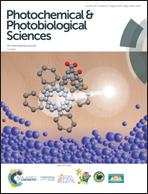New cyanopyridone-based unsymmetrical dyads: the effect of donor strength on their optoelectronic properties†
Abstract
Herein, we describe the design, synthesis and optoelectronic characterization of a new series of highly fluorescent dyes configured with a D–A–D′ architecture, viz. CP1 to CP7. In the new molecular design, various electron-donating scaffolds were integrated with an efficient electron-accepting trialkoxyphenyl-substituted cyanopyridone moiety to study the effect of donor strength on their thermal and opto-physical properties. A detailed investigation of their thermal properties reveals that they are thermally robust with high melting and decomposition temperatures. Furthermore, in-depth photophysical studies expose their remarkable fluorescence ability in both solution and aggregated state within a wide spectral range from blue to orange. Evidently, among all the fluorophores, dyads bearing amino donors were found to be highly intense emitters due to their superior donating strength. Furthermore, solvatochromic studies showcase their ICT-dominated optoelectronic properties and it was confirmed by different correlation studies. Finally, the experimental results were correlated with their quantum chemical simulation data.



 Please wait while we load your content...
Please wait while we load your content...